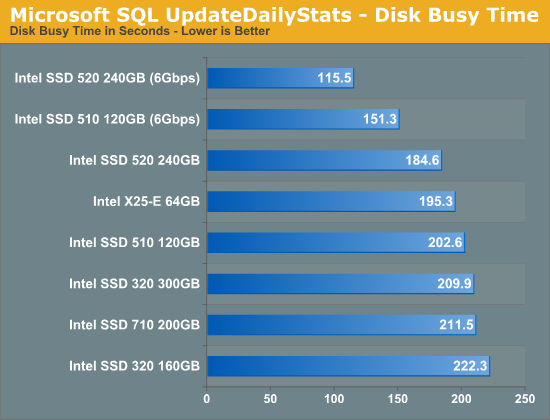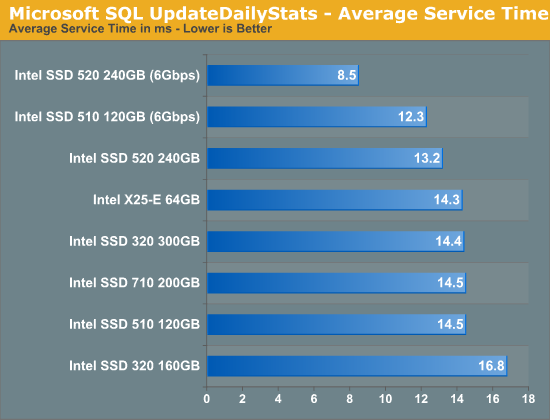A Look at Enterprise Performance of Intel SSDs
by Anand Lal Shimpi on February 8, 2012 6:36 PM EST- Posted in
- Storage
- IT Computing
- SSDs
- Intel
Enterprise Storage Bench - Microsoft SQL UpdateDailyStats
Our next two tests are taken from our own internal infrastructure. We do a lot of statistics tracking at AnandTech - we record traffic data to all articles as well as aggregate traffic for the entire site (including forums) on a daily basis. We also keep track of a running total of traffic for the month. Our first benchmark is a trace of the MS SQL process that does all of the daily and monthly stats processing for the site. We run this process once a day as it puts a fairly high load on our DB server. Then again, we don't have a beefy SSD array in there yet :)
The UpdateDailyStats procedure is mostly reads (3:1 ratio of GB reads to writes) with 431K read operations and 179K write ops. Average queue depth is 4.2 and only 34% of all IOs are issued at a queue depth of 1. The transfer size breakdown is as follows:
| AnandTech Enterprise Storage Bench MS SQL UpdateDaily Stats IO Breakdown | ||||
| IO Size | % of Total | |||
| 8KB | 21% | |||
| 64KB | 35% | |||
| 128KB | 35% | |||

Our SQL tests are much more dependent on sequential throughput and thus we really see some impressive gains from moving to a 6Gbps SATA interface. Among the 3Gbps results the Intel SSD 520 is now the top performer, followed once again by the X25-E. To be honest, most of these drives do perform the same as they bump into the limits of 3Gbps SATA.


Once again we see a huge reduction in service time from the Intel SSD 520 running on a 6Gbps interface. Even on a 3Gbps interface the 520 takes the lead while the bulk of the 3Gbps drives cluster together around 14.4ms. Note the tangible difference in performance between the 300GB and 160GB Intel SSD 320. The gap isn't purely because of additional NAND parallelism, the 300GB drive ends up with more effective spare area since the workload size doesn't scale up with drive capacity. What you're looking at here is the impact of spare area on performance.










55 Comments
View All Comments
Anand Lal Shimpi - Wednesday, February 8, 2012 - link
There's a *ton* of data that we manage. We run statistics, ad serving and forums all in house. Among other things, we can guarantee that no one funny is looking at the data we manage.Statistics are pretty beefy (they are one of our enterprise workloads after all) as we're tracking requests to all articles published. Couple a few hundred thousand readers per day with multiple article requests per reader and that's a lot of traffic to keep track of. Multiply all of that by a few ads per page and you can see where ad serving/tracking gets insane.
Then there are the forums. Repeat the same workload as above but across a different, but also quite large community.
The MS SQL server is main site, the My SQL server is forums + ads :)
Take care,
Anand
Lord 666 - Wednesday, February 8, 2012 - link
@Anand,What model server and what controller was it using with the qty 8 320 drives? Been waiting for an article like for this for some time.
Anand Lal Shimpi - Thursday, February 9, 2012 - link
The temporary hardware is a Dell R710 I believe. We're simply using Intel's Matrix RAID, no real need for a discrete PCIe RAID solution for what we're doing. I'll be providing more details about our final hardware configuration and how it compares to what we were running on for the past few years in the not too distant future.Take care,
Anand
mojobary - Thursday, February 9, 2012 - link
Hi,This is exactly the information I am interested in. I am a video editor, so my needs are typically long sequential reads. I would be interested in RAID adapters, iSCSI and Fibre channel RAID enclosures in respect to using SSDs. This is something that not much good information is present out in the wild. I have been researching this topic for about nine months and do not have conclusive information. Even from vendors which say "they support ssd", they don't list supported drives or even TRIM support. I typically like this site as it seems unbiased in the regard and usually helps me drive purchasing decisions.
bobbozzo - Monday, February 13, 2012 - link
HDDs are pretty good at sequential reads (and writes).For the same $, you'd be able to get more HDDs, and therefore higher sequential performance, than SSDs.
This will remain true until SSDs get MUCH faster sequential performance, or get MUCH cheaper than they currently are.
Movieman420 - Wednesday, February 8, 2012 - link
Given the 710's obvious benefit of using HET nand it'd be nice to see a comparison between it and an eMLC equipped Ocz SF2500 Deneva 2 drive. :evil grin:Anand Lal Shimpi - Thursday, February 9, 2012 - link
I'm trying to get more enterprise SSDs in house. I've got a bunch that I'm working on now actually. Not the Deneva 2 sadly :)Take care,
Anand
Sufo - Thursday, February 9, 2012 - link
How about the HP for ProLiant drives? Also, anything from Anobit?Is the 710 a realistic option for enterprise?
zepi - Wednesday, February 8, 2012 - link
I was hoping on some input regarding TRIM and SSD RAIDs in enterprise environments. What if I stick these babies to a proper raid-controller to run them in RAID 5? Or how about under other operating systems than Windows? Do the drives choke quickly if trim is not available or is it a non-issue? Does trim work in a software RAID array, assuming my operating system supports it? And how about trim / garbage collection behavior if the drives are never idle?Afaik Intel has released RAID 0- and RAID 1-compatible drivers that support trim, but only for Windows. Was that active in your test or does it even matter the slightest?
lonestar212 - Wednesday, February 8, 2012 - link
I was about ask exactly the same thing. Very curious about this!